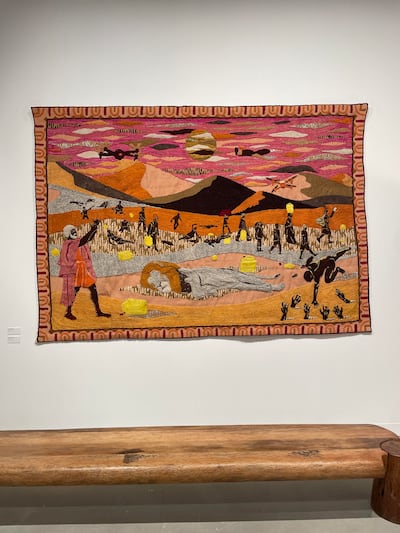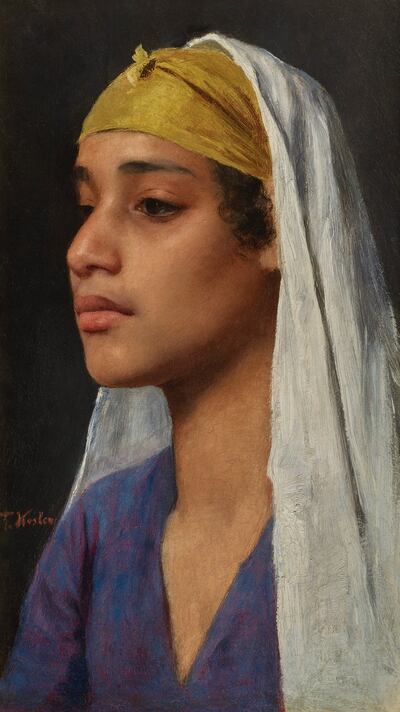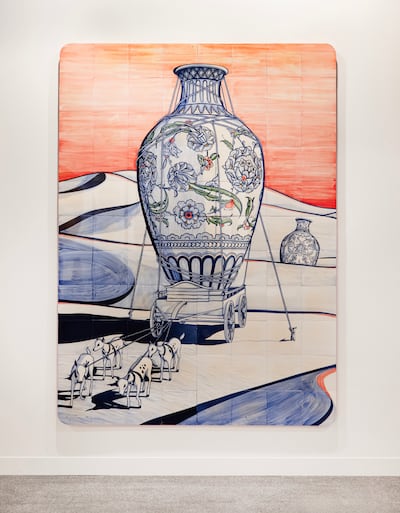Abu Dhabi Art 2024 is in full swing, bringing collections from more than 100 galleries from across the region and the world.
Running at Manarat Al Saadiyat until Sunday, the fair showcases a diverse set of works from emerging and established artists as well as important figures in the Arab art world.
From hyper-surrealist sculptures to orientalist portraits and dramatic wall tapestries, here are The National’s 10 must-see works at this year’s fair.
Hannon au pays de la soif (Hannon in the Land of Thirst) by Louis Barthelemy, Bousnina Gallery (2024)
Created by the artist in partnership with the Tili Tanit workshop in Mahdia, Tunisia, this richly textured wall tapestry depicts a vivid scene full of art historical references.
Using materials such as camel wool, plastic, bronze thread and traditional embroidery the viewer is confronted with a tragic scene of sub-Saharan migrants crossing the desert. From migrants marching across the plains, some collapsing and others barely able to walk, to a dead lion placed in the focal point of the composition and military drones capturing the scene, French artist Louis Barthelemy was interested in exploring themes of migration, survival, and disillusionment that directly contrast the idealised and romantic notions of the sub-Saharan desert.
Aside from the vivid scene, dramatic composition and wonderful use of colours, the work also combines Tunisia’s textile heritage with powerful contemporary themes.
Jerusalem by Nabil Anani, Zaweyah Gallery (2024)
Nabil Anani was a founder of the contemporary Palestinian art movement where his work with the subject of the Palestinian landscape is always depicted free of disruptions, borders and settlements.
His work Jerusalem is exemplary, which depicts this idealised notion of his homeland, a vision for a peaceful and harmonious future. This utopian view of Jerusalem is painted with a blend of memory and imagination where the city is free of the realities of the occupation. Anani’s use of flat spaces, a brighter colour palate and different textures gives the work a vibrant energy bursting with life.
Chipped Grain by Jeremy Fung, SC Gallery (2020)
A piece that is both bold and filled with detail, Hong Kong artist Jeremy Fung’s work has a powerful presence.
The painted and woodcut technique depicts various symbols representing emotions, experiences or states of existence. The work consists of several layers of wood, which allows for different textures and marks he’s made on the material to come through contrasted against the other smoother areas. This relationship, as well as with Fung’s painterly markings, reveals his fluid hand and his spontaneous creative process.
His intuitive approach isn’t only part of the process of art making but is also connected to the themes Fung is working with such as existentialism and the soul’s relationship with the world.
Portrait of an Egyptian Girl by Franz Xaver Kosler, Ary Jan Gallery (1890s)
Franz Xaver Kosler was an Austrian painter known for his Orientalist portraits and genre scenes, which he painted in Egypt and the Balkans.
His portraits were often painted in soft tones and intimate compositions. In this small portrait, the face of a young Egyptian woman is contrasted against a neutral background allowing the viewer to observe the beautiful details of her expression and dress revealing Kosler’s masterful hand and his ability to render not only colour and light but the spirit of his sitter.
Transporters 2024 by Ertugrul Gungor and Faruk Ertekin, Anna Laudel Gallery (2024)
Transporters 2024, a piece that was specially made for Abu Dhabi Art, is both playful and powerful.
The ceramic glazed painting, which includes 18-karat gold details, depicts the vast desert’s red sands where a group of fawns or young deer carry a colossal Iznik vase. The blue and white colour palate is a link back to the history of ceramics and particularly the ancient trade routes between East and West.
The Iznik vase is painted in a floral pattern, a stark contrast to the red dunes in the background, and acts as a symbol of a major theme of the work – cultural exchange.
Net-Grid (Red Emma) by Mandy El-Sayegh, Lawrie Shabibi Gallery (2024)
Part of Chinese-Palestinian artist Mandy El-Sayegh’s Net-Grid series, these works overlay silkscreen prints, personal memorabilia, found objects and linguistic elements with hand-painted grids.
The work is mesmerising, with the viewer discovering layer upon layer of material and meaning with the painted grids that hold the composition together turns the piece into a while but also emphasises the concept of fragility and incompleteness.
The series continues El-Sayegh’s interest and examination of how social, cultural and political conventions are formed and deconstructed in the contemporary world.
Woman Among Deer and Doves by Aly Ben Salem, El Marsa Gallery (1950s)
El Marsa gallery’s booth at the fair is dedicated to the work of the pioneering Tunisian painter Aly Ben Salem. This piece, Woman Among Deer and Doves, displays his unique style that was influenced by traditional Tunisian craft, Persian miniatures and Fauvism.
Meticulously rendered, with stunning detail, a profound use of colour and lively compositions this work is feminine, bold, symbolic and imaginative.
Daughter of Abd-el Rassoul by Mohammed Naghi, Arab Presences exhibition (1939)
From the influential Egyptian artist and cultural figure Mohammed Naghi comes this stunning portrait of a woman simply known as the Daughter of Abd-el Rassoul. Part of the Arab Presences: Modern Art and Decolonisation, Paris 1908-1988 – Farjam Collection Close-Up exhibition at the fair, this work is accompanied by up to 50 artworks from the Farjam Collection, including works by modern masters and pioneers.
Naghi was a prominent member of Al-Ruwwad, the first generation of Egyptian modern artists, and played a key role in shaping Egypt's art scene and cultural institutions. While he was influenced by a number of European art movements such as impressionism, Fauvism and cubism, his work was also a celebration of Egyptian cultural heritage and incorporated themes from ancient Egyptian iconography.
Bu-Darya: A Ripple from 1991 by Jasem Alsanea, Gallery Bawa (2024)
In this hyper-surrealist sculpture, Kuwaiti artist Jasem Alsanea creates a work that draws from the Khaleeji myth of Bu-Daryah, a half-human half-amphibian creature who preyed on sailors, and his country’s history in pearl diving and the modern oil economy.
With oil oozing out of Bu-Daryah's mouth, the work fuses the myth with the environmental impact and concerns of the oil economy and the 1991 invasion of Iraq into Kuwait, to present concepts and themes around the environment and the effects of war.
Balah by Marawa Najjar, Wadi Finan Art Gallery (2024)
Jordanian artist Marawa Najjar’s painting of a man, perhaps a date farmer, walking through palm trees is an evocative scene of rural life. Her expressive brushstrokes and thick application of paint depict a scene full of light and the slow rhythmic energy of country life in warm weather.
Through the depiction of palm tree farms of the Arabian Peninsula, particularly in the Gulf, the work acts as an exploration of the human experience, celebration and homage to the rich heritage of the region.
She is influenced by the works of the Austrian painter Gustav Klimt and Byzantine iconography of the 15th and 16th centuries, all of which can be seen in her use of gold and silver leaf, particularly on the dates the figure carries.
Abu Dhabi Art runs at Manarat Al Saadiyat until Sunday
Zayed Sustainability Prize
The five pillars of Islam
Company%C2%A0profile
%3Cp%3E%3Cstrong%3ECompany%20name%3A%20%3C%2Fstrong%3EHayvn%3Cbr%3E%3Cstrong%3EStarted%3A%20%3C%2Fstrong%3E2018%3Cbr%3E%3Cstrong%3EFounders%3A%20%3C%2Fstrong%3EChristopher%20Flinos%2C%20Ahmed%20Ismail%3Cbr%3E%3Cstrong%3EBased%3A%20%3C%2Fstrong%3EAbu%20Dhabi%2C%20UAE%3Cbr%3E%3Cstrong%3ESector%3A%20%3C%2Fstrong%3Efinancial%3Cbr%3E%3Cstrong%3EInitial%20investment%3A%20%3C%2Fstrong%3Eundisclosed%3Cbr%3E%3Cstrong%3ESize%3A%3C%2Fstrong%3E%2044%20employees%3Cbr%3E%3Cstrong%3EInvestment%20stage%3A%20%3C%2Fstrong%3Eseries%20B%20in%20the%20second%20half%20of%202023%3Cbr%3E%3Cstrong%3EInvestors%3A%20%3C%2Fstrong%3EHilbert%20Capital%2C%20Red%20Acre%20Ventures%3C%2Fp%3E%0A
How to wear a kandura
Dos
- Wear the right fabric for the right season and occasion
- Always ask for the dress code if you don’t know
- Wear a white kandura, white ghutra / shemagh (headwear) and black shoes for work
- Wear 100 per cent cotton under the kandura as most fabrics are polyester
Don’ts
- Wear hamdania for work, always wear a ghutra and agal
- Buy a kandura only based on how it feels; ask questions about the fabric and understand what you are buying
From Zero
Artist: Linkin Park
Label: Warner Records
Number of tracks: 11
Rating: 4/5
COMPANY PROFILE
Name: Kumulus Water
Started: 2021
Founders: Iheb Triki and Mohamed Ali Abid
Based: Tunisia
Sector: Water technology
Number of staff: 22
Investment raised: $4 million
KILLING OF QASSEM SULEIMANI
The five pillars of Islam
Killing of Qassem Suleimani
CABINET%20OF%20CURIOSITIES%20EPISODE%201%3A%20LOT%2036
%3Cp%3E%3Cstrong%3EDirector%3A%20%3C%2Fstrong%3EGuillermo%20del%20Toro%3Cbr%3E%3Cstrong%3EStars%3A%3C%2Fstrong%3E%20Tim%20Blake%20Nelson%2C%20Sebastian%20Roche%2C%20Elpidia%20Carrillo%3Cbr%3ERating%3A%204%2F5%3C%2Fp%3E%0A
The%20specs%20
%3Cp%3E%3Cstrong%3EEngine%3A%20%3C%2Fstrong%3E2.0-litre%204cyl%20turbo%0D%3Cbr%3E%3Cstrong%3EPower%3A%20%3C%2Fstrong%3E261hp%20at%205%2C500rpm%0D%3Cbr%3E%3Cstrong%3ETorque%3A%20%3C%2Fstrong%3E400Nm%20at%201%2C750-4%2C000rpm%0D%3Cbr%3E%3Cstrong%3ETransmission%3A%20%3C%2Fstrong%3E7-speed%20dual-clutch%20auto%0D%3Cbr%3E%3Cstrong%3EFuel%20consumption%3A%20%3C%2Fstrong%3E10.5L%2F100km%0D%3Cbr%3E%3Cstrong%3EOn%20sale%3A%20%3C%2Fstrong%3ENow%0D%3Cbr%3E%3Cstrong%3EPrice%3A%20%3C%2Fstrong%3EFrom%20Dh129%2C999%20(VX%20Luxury)%3B%20from%20Dh149%2C999%20(VX%20Black%20Gold)%3C%2Fp%3E%0A
WandaVision
Starring: Elizabeth Olsen, Paul Bettany
Directed by: Matt Shakman
Rating: Four stars
UAE currency: the story behind the money in your pockets
Getting%20there%20and%20where%20to%20stay
%3Cp%3EEtihad%20Airways%20operates%20seasonal%20flights%20from%20Abu%20Dhabi%20to%20Nice%20C%C3%B4te%20d'Azur%20Airport.%20Services%20depart%20the%20UAE%20on%20Wednesdays%20and%20Sundays%20with%20outbound%20flights%20stopping%20briefly%20in%20Rome%2C%20return%20flights%20are%20non-stop.%20Fares%20start%20from%20Dh3%2C315%2C%20flights%20operate%20until%20September%2018%2C%202022.%C2%A0%3C%2Fp%3E%0A%3Cp%3EThe%20Radisson%20Blu%20Hotel%20Nice%20offers%20a%20western%20location%20right%20on%20Promenade%20des%20Anglais%20with%20rooms%20overlooking%20the%20Bay%20of%20Angels.%20Stays%20are%20priced%20from%20%E2%82%AC101%20(%24114)%2C%20including%20taxes.%3C%2Fp%3E%0A%3Cp%3E%3C%2Fp%3E%0A
Specs
Engine: 51.5kW electric motor
Range: 400km
Power: 134bhp
Torque: 175Nm
Price: From Dh98,800
Available: Now
Killing of Qassem Suleimani
UAE currency: the story behind the money in your pockets
More from Neighbourhood Watch:
More from Rashmee Roshan Lall
Where to donate in the UAE
The Emirates Charity Portal
You can donate to several registered charities through a “donation catalogue”. The use of the donation is quite specific, such as buying a fan for a poor family in Niger for Dh130.
The General Authority of Islamic Affairs & Endowments
The site has an e-donation service accepting debit card, credit card or e-Dirham, an electronic payment tool developed by the Ministry of Finance and First Abu Dhabi Bank.
Al Noor Special Needs Centre
You can donate online or order Smiles n’ Stuff products handcrafted by Al Noor students. The centre publishes a wish list of extras needed, starting at Dh500.
Beit Al Khair Society
Beit Al Khair Society has the motto “From – and to – the UAE,” with donations going towards the neediest in the country. Its website has a list of physical donation sites, but people can also contribute money by SMS, bank transfer and through the hotline 800-22554.
Dar Al Ber Society
Dar Al Ber Society, which has charity projects in 39 countries, accept cash payments, money transfers or SMS donations. Its donation hotline is 800-79.
Dubai Cares
Dubai Cares provides several options for individuals and companies to donate, including online, through banks, at retail outlets, via phone and by purchasing Dubai Cares branded merchandise. It is currently running a campaign called Bookings 2030, which allows people to help change the future of six underprivileged children and young people.
Emirates Airline Foundation
Those who travel on Emirates have undoubtedly seen the little donation envelopes in the seat pockets. But the foundation also accepts donations online and in the form of Skywards Miles. Donated miles are used to sponsor travel for doctors, surgeons, engineers and other professionals volunteering on humanitarian missions around the world.
Emirates Red Crescent
On the Emirates Red Crescent website you can choose between 35 different purposes for your donation, such as providing food for fasters, supporting debtors and contributing to a refugee women fund. It also has a list of bank accounts for each donation type.
Gulf for Good
Gulf for Good raises funds for partner charity projects through challenges, like climbing Kilimanjaro and cycling through Thailand. This year’s projects are in partnership with Street Child Nepal, Larchfield Kids, the Foundation for African Empowerment and SOS Children's Villages. Since 2001, the organisation has raised more than $3.5 million (Dh12.8m) in support of over 50 children’s charities.
Noor Dubai Foundation
Sheikh Mohammed bin Rashid Al Maktoum launched the Noor Dubai Foundation a decade ago with the aim of eliminating all forms of preventable blindness globally. You can donate Dh50 to support mobile eye camps by texting the word “Noor” to 4565 (Etisalat) or 4849 (du).
Zayed Sustainability Prize
UAE currency: the story behind the money in your pockets
Mohammed bin Zayed Majlis
The years Ramadan fell in May
Killing of Qassem Suleimani
Killing of Qassem Suleimani
U19 WORLD CUP, WEST INDIES
UAE group fixtures (all in St Kitts)
- Saturday 15 January: UAE beat Canada by 49 runs
- Thursday 20 January: v England
- Saturday 22 January: v Bangladesh
UAE squad:
Alishan Sharafu (captain), Shival Bawa, Jash Giyanani, Sailles
Jaishankar, Nilansh Keswani, Aayan Khan, Punya Mehra, Ali Naseer, Ronak Panoly,
Dhruv Parashar, Vinayak Raghavan, Soorya Sathish, Aryansh Sharma, Adithya
Shetty, Kai Smith
How the bonus system works
The two riders are among several riders in the UAE to receive the top payment of £10,000 under the Thank You Fund of £16 million (Dh80m), which was announced in conjunction with Deliveroo's £8 billion (Dh40bn) stock market listing earlier this year.
The £10,000 (Dh50,000) payment is made to those riders who have completed the highest number of orders in each market.
There are also riders who will receive payments of £1,000 (Dh5,000) and £500 (Dh2,500).
All riders who have worked with Deliveroo for at least one year and completed 2,000 orders will receive £200 (Dh1,000), the company said when it announced the scheme.
TEST SQUADS
Bangladesh: Mushfiqur Rahim (captain), Tamim Iqbal, Soumya Sarkar, Imrul Kayes, Liton Das, Shakib Al Hasan, Mominul Haque, Nasir Hossain, Sabbir Rahman, Mehedi Hasan, Shafiul Islam, Taijul Islam, Mustafizur Rahman and Taskin Ahmed.
Australia: Steve Smith (captain), David Warner, Ashton Agar, Hilton Cartwright, Pat Cummins, Peter Handscomb, Matthew Wade, Josh Hazlewood, Usman Khawaja, Nathan Lyon, Glenn Maxwell, Matt Renshaw, Mitchell Swepson and Jackson Bird.
What is Bitcoin?
Bitcoin is the most popular virtual currency in the world. It was created in 2009 as a new way of paying for things that would not be subject to central banks that are capable of devaluing currency. A Bitcoin itself is essentially a line of computer code. It's signed digitally when it goes from one owner to another. There are sustainability concerns around the cryptocurrency, which stem from the process of "mining" that is central to its existence.
The "miners" use computers to make complex calculations that verify transactions in Bitcoin. This uses a tremendous amount of energy via computers and server farms all over the world, which has given rise to concerns about the amount of fossil fuel-dependent electricity used to power the computers.
Indian origin executives leading top technology firms
Sundar Pichai
Chief executive, Google and Alphabet
Satya Nadella
Chief executive, Microsoft
Ajaypal Singh Banga
President and chief executive, Mastercard
Shantanu Narayen
Chief executive, chairman, and president, Adobe
Indra Nooyi
Board of directors, Amazon and former chief executive, PepsiCo
SPECS%3A%20Polestar%203
%3Cp%3E%3Cstrong%3EEngine%3A%20%3C%2Fstrong%3ELong-range%20dual%20motor%20with%20400V%20battery%3Cbr%3E%3Cstrong%3EPower%3A%20%3C%2Fstrong%3E360kW%20%2F%20483bhp%3Cbr%3E%3Cstrong%3ETorque%3A%20%3C%2Fstrong%3E840Nm%3Cbr%3E%3Cstrong%3ETransmission%3A%20%3C%2Fstrong%3ESingle-speed%20automatic%3Cbr%3E%3Cstrong%3EMax%20touring%20range%3A%3C%2Fstrong%3E%20628km%3Cbr%3E%3Cstrong%3E0-100km%2Fh%3A%3C%2Fstrong%3E%204.7sec%3Cbr%3E%3Cstrong%3ETop%20speed%3A%3C%2Fstrong%3E%20210kph%20%3Cbr%3E%3Cstrong%3EPrice%3A%20%3C%2Fstrong%3EFrom%20Dh360%2C000%3Cbr%3E%3Cstrong%3EOn%20sale%3A%20%3C%2Fstrong%3ESeptember%3Cbr%3E%3C%2Fp%3E%0A
ENGLAND SQUAD
Eoin Morgan (captain), Moeen Ali, Jonny Bairstow, Sam Billings, Jos Buttler, Tom Curran, Alex Hales, Liam Plunkett, Adil Rashid, Joe Root, Jason Roy, Ben Stokes, David Willey, Chris Woakes, Mark Wood
Killing of Qassem Suleimani
The specs
Engine: 8.0-litre, quad-turbo 16-cylinder
Transmission: 7-speed auto
0-100kmh 2.3 seconds
0-200kmh 5.5 seconds
0-300kmh 11.6 seconds
Power: 1500hp
Torque: 1600Nm
Price: Dh13,400,000
On sale: now
The years Ramadan fell in May
Other ways to buy used products in the UAE
UAE insurance firm Al Wathba National Insurance Company (AWNIC) last year launched an e-commerce website with a facility enabling users to buy car wrecks.
Bidders and potential buyers register on the online salvage car auction portal to view vehicles, review condition reports, or arrange physical surveys, and then start bidding for motors they plan to restore or harvest for parts.
Physical salvage car auctions are a common method for insurers around the world to move on heavily damaged vehicles, but AWNIC is one of the few UAE insurers to offer such services online.
For cars and less sizeable items such as bicycles and furniture, Dubizzle is arguably the best-known marketplace for pre-loved.
Founded in 2005, in recent years it has been joined by a plethora of Facebook community pages for shifting used goods, including Abu Dhabi Marketplace, Flea Market UAE and Arabian Ranches Souq Market while sites such as The Luxury Closet and Riot deal largely in second-hand fashion.
At the high-end of the pre-used spectrum, resellers such as Timepiece360.ae, WatchBox Middle East and Watches Market Dubai deal in authenticated second-hand luxury timepieces from brands such as Rolex, Hublot and Tag Heuer, with a warranty.
Illegal%20shipments%20intercepted%20in%20Gulf%20region
%3Cp%3EThe%20Royal%20Navy%20raid%20is%20the%20latest%20in%20a%20series%20of%20successful%20interceptions%20of%20drugs%20and%20arms%20in%20the%20Gulf%3C%2Fp%3E%0A%3Cp%3E%3Cstrong%3EMay%2011%3A%20%3C%2Fstrong%3EUS%20coastguard%20recovers%20%2480%20million%20heroin%20haul%20from%20fishing%20vessel%20in%20Gulf%20of%20Oman%3C%2Fp%3E%0A%3Cp%3E%3Cstrong%3EMay%208%3A%3C%2Fstrong%3E%20US%20coastguard%20vessel%20USCGC%20Glen%20Harris%20seizes%20heroin%20and%20meth%20worth%20more%20than%20%2430%20million%20from%20a%20fishing%20boat%3C%2Fp%3E%0A%3Cp%3E%3Cstrong%3EMarch%202%3A%3C%2Fstrong%3E%20Anti-tank%20guided%20missiles%20and%20missile%20components%20seized%20by%20HMS%20Lancaster%20from%20a%20small%20boat%20travelling%20from%20Iran%3C%2Fp%3E%0A%3Cp%3E%3Cstrong%3EOctober%209%2C%202022%3A%20%3C%2Fstrong%3ERoyal%20Navy%20frigate%20HMS%20Montrose%20recovers%20drugs%20worth%20%2417.8%20million%20from%20a%20dhow%20in%20Arabian%20Sea%3C%2Fp%3E%0A%3Cp%3E%3Cstrong%3ESeptember%2027%2C%202022%3A%3C%2Fstrong%3E%20US%20Naval%20Forces%20Central%20Command%20reports%20a%20find%20of%202.4%20tonnes%20of%20heroin%20on%20board%20fishing%20boat%20in%20Gulf%20of%20Oman%C2%A0%3C%2Fp%3E%0A
DUNGEONS%20%26%20DRAGONS%3A%20HONOR%20AMONG%20THIEVES
%3Cp%3EDirectors%3A%20John%20Francis%20Daley%20and%20Jonathan%20Goldstein%3Cbr%3EStars%3A%20Chris%20Pine%2C%20Michelle%20Rodriguez%2C%20Rege-Jean%20Page%2C%20Justice%20Smith%2C%20Sophia%20Lillis%3Cbr%3ERating%3A%203%2F5%3C%2Fp%3E%0A
Mohammed bin Zayed Majlis











